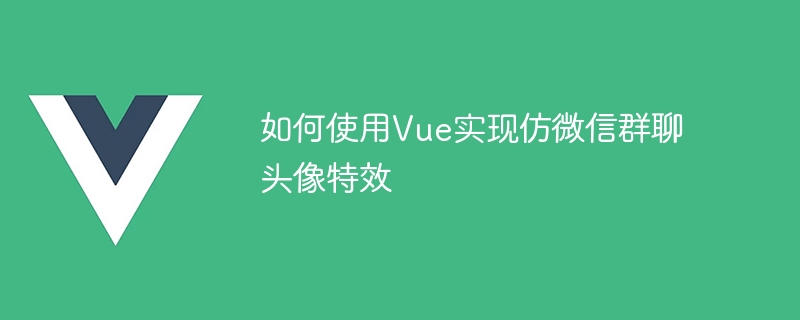
如何使用Vue實作仿微信群組聊天頭像特效
#隨著社群媒體的發展,我們常在各種應用中看到各種有趣的特效。其中,仿微信群組聊天頭像特效是一種非常流行的效果。在這篇文章中,我們將教你如何使用Vue框架來實現這種特效,並提供一些具體的程式碼範例。
在開始之前,我們需要先準備好開發環境。確保你已經安裝好了Node.js和Vue CLI。如果沒有安裝的話,可以透過以下命令來安裝:
npm install -g vue-cli
接下來,我們建立一個新的Vue專案:
vue create wechat-avatar-effect
進入專案資料夾並執行專案:
cd wechat-avatar-effect npm run serve
現在我們已經準備好開始編碼了。
首先,我們需要介紹所需的樣式表和圖片。在src/assets目錄下建立一個新的資料夾,命名為css,並在其中建立一個新的檔案styles.css。在styles.css中新增以下程式碼:
.avatar-effect {
position: relative;
display: inline-flex;
align-items: center;
justify-content: center;
width: 48px;
height: 48px;
border-radius: 50%;
background-repeat: no-repeat;
background-size: cover;
}
.avatar-effect:before {
content: "";
position: absolute;
top: 0;
left: 0;
display: block;
width: 100%;
height: 100%;
border-radius: 50%;
background-color: rgba(0, 0, 0, 0.5);
opacity: 0;
}
.avatar-effect:hover:before {
opacity: 1;
}
.group-count {
position: absolute;
top: 50%;
left: 50%;
transform: translate(-50%, -50%);
color: #fff;
font-size: 12px;
}在src/assets目錄下建立一個新的資料夾,命名為images,並將微信群組聊天頭像的圖片檔案拖曳到該資料夾中。
接下來,我們將建立一個新的Vue元件Avatar.vue。在src/components目錄下建立一個新的檔案Avatar.vue,並加入以下程式碼:
<template>
<div class="avatar-effect" :style="avatarStyle">
<img :src="require('@/assets/images/' + image)" alt="avatar">
<span class="group-count" v-if="showCount">{{ count }}</span>
</div>
</template>
<script>
export default {
props: {
image: {
type: String,
required: true
},
count: {
type: Number,
default: 0
},
showCount: {
type: Boolean,
default: true
}
},
computed: {
avatarStyle() {
return `background-image: url(${require('@/assets/images/' + this.image)})`;
}
}
};
</script>
<style scoped>
@import '@/assets/css/styles.css';
</style>在上述程式碼中,我們建立了一個Avatar元件,並定義了三個屬性:image、count和showCount。 image屬性是必要的屬性,用於指定頭像圖片的檔案名稱;count屬性是可選的,用於指定頭像中的人數;showCount屬性是可選的,用於控制是否顯示人數。 computed屬性avatarStyle用於動態計算頭像的背景圖片樣式。
接下來,我們將使用Avatar元件來實現仿微信群組聊天頭像特效。在src/App.vue中加入以下程式碼:
<template>
<div id="app">
<h1>WeChat Avatar Effect</h1>
<div class="avatar-container">
<Avatar v-for="(avatar, index) in avatars" :key="index" :image="avatar.image" :count="avatar.count" :showCount="true" />
</div>
</div>
</template>
<script>
import Avatar from "./components/Avatar.vue";
export default {
name: "App",
components: {
Avatar
},
data() {
return {
avatars: [
{
image: "avatar1.jpg",
count: 10
},
{
image: "avatar2.jpg",
count: 5
},
{
image: "avatar3.jpg",
count: 0
}
]
};
}
};
</script>
<style>
.avatar-container {
display: flex;
justify-content: center;
align-items: center;
margin-top: 20px;
}
</style>在上述程式碼中,我們在App元件中引入了Avatar元件,並使用v-for指令來循環渲染一組頭像。 avatars數組是模擬的頭像數據,其中包含了每個頭像的圖片和人數。
運行項目,你將會看到一個仿微信群聊頭像特效的頁面,包含了多個頭像以及對應的人數。
至此,我們已經成功使用Vue實現了仿微信群組聊天頭像特效。透過程式碼範例,我們了解如何建立一個Avatar元件,並使用props屬性傳遞資料。另外,我們也使用了CSS樣式來達到了特效的效果。
希望這篇文章對您有幫助,感謝您的閱讀!
以上是如何使用Vue實現仿微信群組聊天頭像特效的詳細內容。更多資訊請關注PHP中文網其他相關文章!



